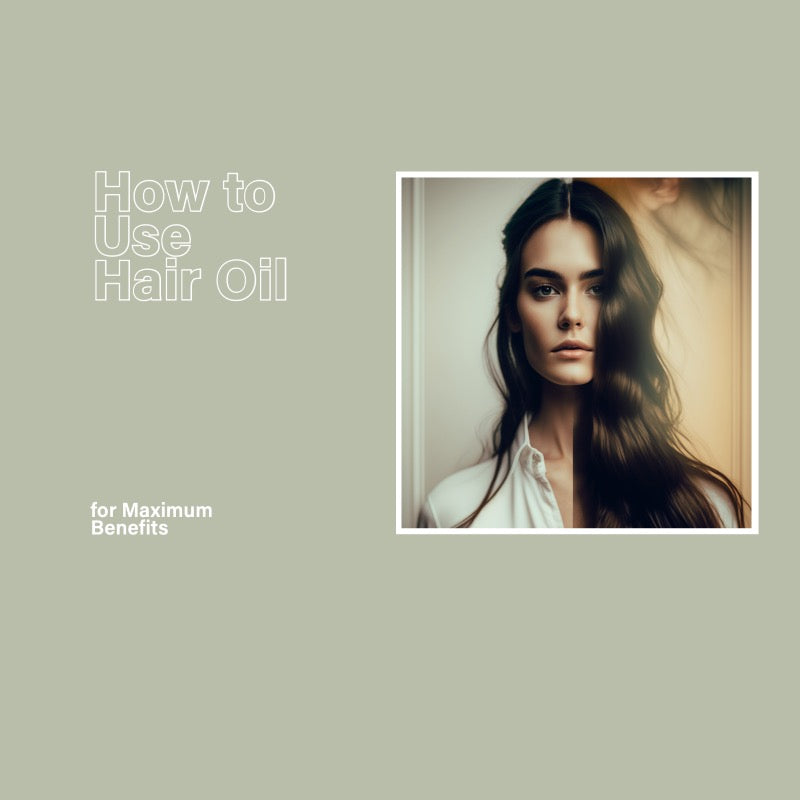Hair oils have become a staple in our hair care routines, and for a good reason. They offer many benefits, from nourishing and strengthening our tresses to improving scalp health and preventing breakage. But to truly unlock their full potential, knowing how to use hair oil properly is essential.
In this comprehensive guide, we'll walk you through the ins and outs of hair oil application, featuring our very own Daily Drip, and share tips and tricks to ensure you're getting the most out of your product.
Understanding Hair Oils: Choosing the Right One for Your Needs
Before diving into the application process, it's crucial to understand the different types of hair oils available and identify the best one for your needs. Some hair oils are designed to nourish and hydrate, while others offer heat protection or help tame frizz.
Our Daily Drip hair oil, for example, is a powerful blend formulated for ultimate nourishment, hydration, and UV protection. Its thick and oily texture makes it perfect for dry, damaged, or frizzy hair types. The key ingredient, Camellia Flower, contributes to the oil's powerful effects, resulting in soft, shiny hair that's deeply hydrated and nourished.
Prepping Your Hair for Hair Oil Application
One of the most common mistakes people make when applying hair oil is not prepping their hair correctly. Here's how to do it right:
- Detangle your hair: Before applying hair oil, gently detangle your hair using a wide-tooth comb. This ensures the even distribution of the oil and prevents breakage.
- Dampen your hair: While some oils can be applied to dry hair, many experts recommend using hair oil to dampen hair for better absorption. Lightly mist your hair with water, or use the oil after towel-drying post-shower.
Applying Hair Oil: A Step-by-Step Guide
Now that you've chosen the right hair oil and prepped your hair let's dive into the application process.
Step 1: Dispense the right amount of hair oil
Too much hair oil can leave your hair greasy and weighed down, while too little might not provide the desired benefits. As a general rule of thumb, start with a pea-sized amount of hair oil (like our Daily Drip) and adjust based on your hair length and thickness. For short or thin hair, a pea-sized amount should suffice, while those with longer or thicker hair may need a bit more.
Step 2: Warm the oil in your hands
Place the hair oil in the palm of one hand, then rub your hands together to warm it up. Warming the oil makes it easier to distribute evenly throughout your hair. In addition, it helps it penetrate the hair shaft more effectively.
Step 3: Apply the oil to your hair
Starting at the mid-lengths of your hair, work the oil through your strands, focusing on the ends where damage is most likely to occur. Use your fingers or a wide toothcomb to ensure even distribution. Remember, a little goes a long way, so it's better to start with less and add more if needed. Be sure to avoid applying the oil directly to your scalp, as this can lead to an oily, weighed-down appearance.
Step 4: Leave the oil in your hair
Allow the hair oil to work its magic by leaving it in your hair for a designated period. For example, leave the oil in for 15-20 minutes before washing it out for a quick boost. For a more intensive treatment, you can wrap your hair in a shower cap or towel and leave the oil in overnight. This is particularly beneficial for those with severely damaged or dry hair. Our Daily Drip hair oil is an excellent choice, as it provides deep hydration and nourishment while you sleep.
Step 5: Rinse the oil out (optional)
Depending on the hair oil you're using and the desired outcome, you may choose to rinse the oil out after the treatment. Then, you can style your hair with lightweight oils or those designed as a leave-in treatment. For heavier oils, like our Daily Drip, rinse it with a gentle shampoo before conditioning and styling your hair.
Additional Tips for Getting the Most Out of Your Hair Oil
Use hair oil as a pre-shampoo treatment.
Applying hair oil before shampooing can help protect your hair from the stripping effects of some shampoos. Apply the oil to your hair, let it sit for at least 20 minutes, then shampoo and condition it as usual. This method helps lock in moisture and nutrients, leaving your hair soft and manageable.
Combine hair oil with other hair care products.
To enhance the benefits of your hair oil, consider mixing it with other hair care products, such as leave-in conditioners or hair masks. This can create a customized treatment tailored to your hair's specific needs.
Apply hair oil to damp hair before heat styling.
Using hair oil as a heat protectant can shield your hair from the damaging effects of hot tools. Apply a small amount of oil to damp hair, focusing on the mid-lengths and ends, before blow-drying, straightening, or curling your hair. This will not only protect your hair but also add shine and reduce frizz.
Conclusion:
In conclusion, knowing how to use hair oil effectively is key to unlocking its full potential and reaping the maximum benefits for your hair.
By choosing the right hair oil, like our Daily Drip, prepping your hair correctly, and following the step-by-step application guide, you'll be well on your way to achieving soft, shiny, and healthy hair.
Remember to explore additional tips and techniques to enhance your hair oil experience further and treat your tresses to the ultimate care they deserve.
Frequently Asked Questions
Q: What are the disadvantages of hair oil?
A: While hair oil offers numerous benefits, there can be some potential disadvantages when used improperly or excessively. Some potential downsides include the following:
- Over-application: Applying too much hair oil can weigh your hair down and make it appear greasy or oily. Always start with a small amount and build up as needed.
- Clogged pores: Applying hair oil directly to the scalp can lead to clogged pores and, in some cases, an itchy or irritated scalp. To avoid this, focus on applying the oil to the mid-lengths and ends of your hair.
- Allergic reactions: Some individuals may be allergic to specific ingredients in certain hair oils. If you experience any irritation, redness, or itching after using hair oil, discontinue use and consult a healthcare professional.
Q: Why do I lose more hair when I oil it?
A: Losing some hair when oiling is standard, as massaging the oil into your hair can dislodge loose or weak strands. However, if you notice excessive hair loss during or after oiling, there could be a few possible reasons:
- Rough handling: Too aggressive when massaging or combing your hair after oiling can cause breakage and hair loss. Be gentle, and use a wide-tooth comb to detangle your hair.
- Underlying health issues: If you're experiencing significant hair loss, it could be a sign of an underlying health issue, such as hormonal imbalances, nutritional deficiencies, or scalp infections. Consult a healthcare professional for a proper diagnosis and treatment.
Q: Should I comb my hair after oiling it?
A: Yes, combing your hair after oiling can help distribute the oil evenly throughout your strands, ensuring that your hair receives the maximum benefits of the treatment. It's essential to use a wide-tooth comb and to be gentle when detangling to minimize hair breakage and damage. Start from the ends of your hair and work your way up to the roots to avoid pulling or stressing the hair shaft.

